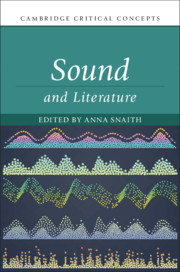Book contents
- Sound and Literature
- Cambridge Critical Concepts
- Sound and Literature
- Copyright page
- Epigraph
- Contents
- Figures
- Contributors
- Acknowledgements
- Introduction
- Part I Origins
- Part II Development
- Part III Applications
- Chapter 10 What We Talk about When We Talk about Talking Books
- Chapter 11 Prose Sense and Its Soundings
- Chapter 12 Dissonant Prosody
- Chapter 13 Deafness and Sound
- Chapter 14 Vibrations
- Chapter 15 Feminism and Sound
- Chapter 16 Wireless Imaginations
- Chapter 17 Attending to Theatre Sound Studies and Complicité’s The Encounter
- Chapter 18 Bob Dylan and Sound: A Tale of the Recording Era
- Bibliography
- Index
Chapter 12 - Dissonant Prosody
from Part III - Applications
Published online by Cambridge University Press: 29 May 2020
- Sound and Literature
- Cambridge Critical Concepts
- Sound and Literature
- Copyright page
- Epigraph
- Contents
- Figures
- Contributors
- Acknowledgements
- Introduction
- Part I Origins
- Part II Development
- Part III Applications
- Chapter 10 What We Talk about When We Talk about Talking Books
- Chapter 11 Prose Sense and Its Soundings
- Chapter 12 Dissonant Prosody
- Chapter 13 Deafness and Sound
- Chapter 14 Vibrations
- Chapter 15 Feminism and Sound
- Chapter 16 Wireless Imaginations
- Chapter 17 Attending to Theatre Sound Studies and Complicité’s The Encounter
- Chapter 18 Bob Dylan and Sound: A Tale of the Recording Era
- Bibliography
- Index
Summary
Prosodic dissonance marks out those most difficult and most stimulating poetic works in rhythm. Poems that do dissonance, from Gerard Manley Hopkins to successive waves of avant-garde poetry over the last century, have confounded commentators and exposed certain analogical faultlines. Recourses to ‘musicality’ in poetry have long assumed that the ‘music’ of a poem must mean, in a word, euphony. Yet a musical poem, as Northrop Frye noted, would withhold rhythmic or rhymic resolve, sporting rugged, crabbed accents and lumbering polysyllables, a sequence of discords only ending with a harmony. Such analogies further do not take into account the centrality of dissonance in twentieth-century music. We therefore need new models and new ways of talking about prosodic dissonance that can take into account a fuller range of poetics. Prosody that attempts such dissonance can be found in the works of Jackson Mac Low, who greatly admired Hopkins. In a reading that follows Frye on Hopkins’s ‘inscape’ I claim that Mac Low seeks ‘outscape’, an emancipation of dissonant potential. Instress becomes outstress, a poetics of clashing exteriors; ‘pure projected detachment’, energy thrown outward and away from the poet, or starting out and finding in.
Keywords
- Type
- Chapter
- Information
- Sound and Literature , pp. 252 - 271Publisher: Cambridge University PressPrint publication year: 2020



